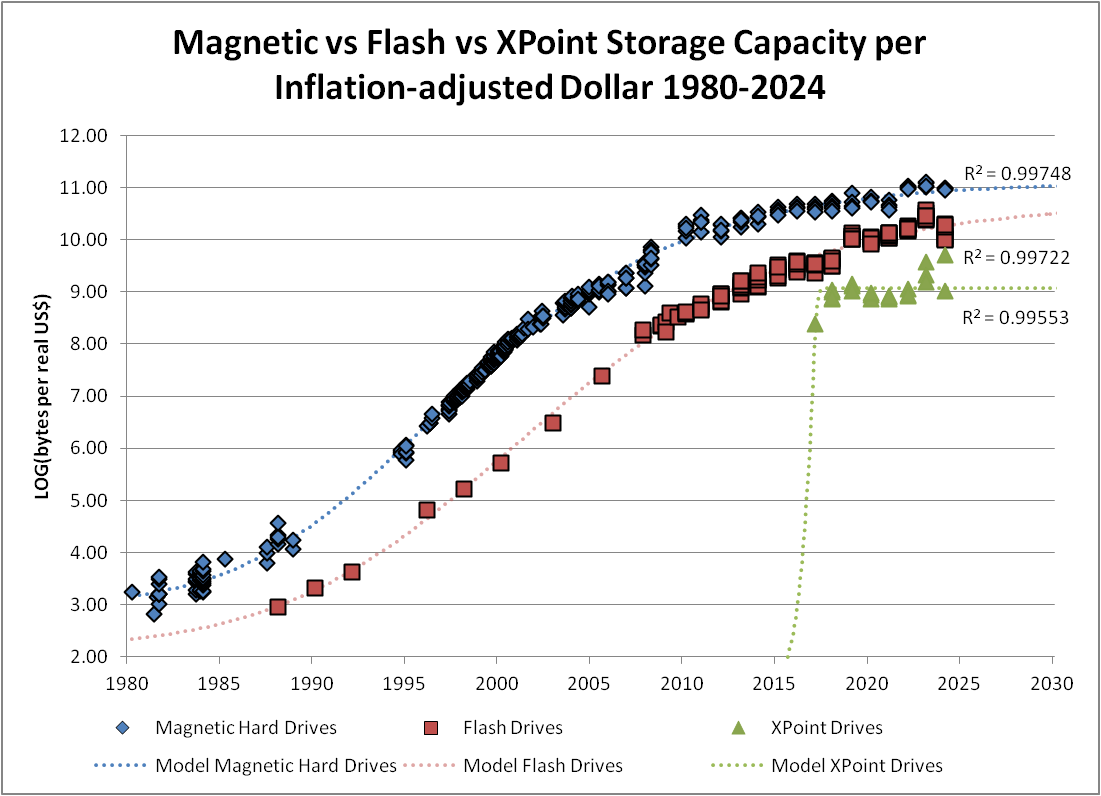Word count: 642. Estimated reading time: 4 minutes.
- Summary:
- The storage manufacturers have been experiencing a significant increase in prices this year, with both hard drives and flash storage seeing large price hikes. This is likely due to the assumption that higher interest rates would reduce demand, but instead, prices have gone up. The capacity per inflation-adjusted dollar has dropped for both spinning rust and SSDs simultaneously, which is unprecedented.
Sunday 2 June 2024: 22:32.
- Summary:
- The storage manufacturers have been experiencing a significant increase in prices this year, with both hard drives and flash storage seeing large price hikes. This is likely due to the assumption that higher interest rates would reduce demand, but instead, prices have gone up. The capacity per inflation-adjusted dollar has dropped for both spinning rust and SSDs simultaneously, which is unprecedented.

Raw data: http://www.nedprod.com/studystuff/SSDsVsHardDrives.xlsx
This time last year I predicted:
This time last year I thought a recession would be upon us by now, as interest rates rose above inflation in order to bring it down. I still think that will happen, it just hasn’t happened yet – interest rates are indeed many times higher than last year, but inflation hasn’t really dropped by much. So either there will be recession sooner rather than later, or interest rates will have to rise some more. In any case, a recession.
It looks like the storage manufacturers were thinking similarly to me: there has been this year a hefty increase in the prices of hard drives and especially flash storage (and remember the above are inflation adjusted, so these are large price increases in real terms). I would assume this is because they curtailed production last year under the assumption that higher interest rates would reduce demand, and then demand didn’t reduce as much as expected so prices have gone up.
Unusually, this year saw a large increase in the price of both spinning rust and SSDs simultaneously. I think this is unprecedented. In previous years, either hard drives or SSDs individually saw large swings in price, but seeing both swing together in the same direction is new. By my reckoning, capacity per inflation adjusted dollar drops (i.e. large price rises) occurred in 2021 (hard drives), 2016 (flash), and 2011 (hard drives). For the hard drives, that was the covid pandemic/Thai floods and the financial crisis respectively; for the 2016 flash price rises, there was a sustained flash shortage for reasons google isn’t finding for me right now, but certainly to build a new fab takes a minimum of two years at best.
Optane’s 960Gb drive saw a hefty price decrease while the largest drive saw a hefty price increase. The 960Gb drive is now affordable – indeed, I bought one myself, and yeah it’s a latency monster. Sticking a few of those in RAID0 makes for some very fast storage, though it would need to drop in price a bit more still to justify say a 4x RAID0 array of them. CXL is supposed to be the long term replacement for Optane, and there are CXL memory expansion devices for sale right now, but they are very much enterprise priced and likely to remain a niche use case. I suppose that makes sense – my Threadripper Pro plus its very expensive motherboard can take a maximum of 1Tb of RAM (8x 128Gb), and its BIOS supports CXL memory expansion. 8x 128Gb Samsung ECC RAM currently costs around €4,600 inc VAT, so if you need more RAM than 1Tb you’re probably into a fairly rarified and enterprisey customer set. I currently have 128Gb fitted which actually comes from the Threadripper before the current board, and while occasionally it’s been constraining it hasn’t been frequent enough to make me consider an upgrade. I’m not that customer set, in other words.
Obviously Optane’s inventory and stock is being run down, so I’m hoping to pick up another three of those 960Gb drives at a very good price at some point. We’ll see how it goes. After that stock is exhausted, I suspend we will be waiting on SSD vendors to expose zoned storage to consumer level drives to see Optane-like i/o latencies – frustratingly, this is currently 100% a firmware choice by the vendors, they could flip it on tomorrow for recent SSDs if they wanted. Chances are it’ll only take one to do it to force everybody else to follow, so here’s hoping!
| Go to previous entry | Go to next entry | Go back to the archive index | Go back to the latest entries |